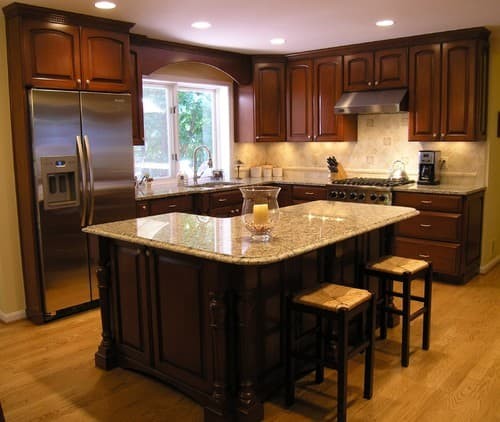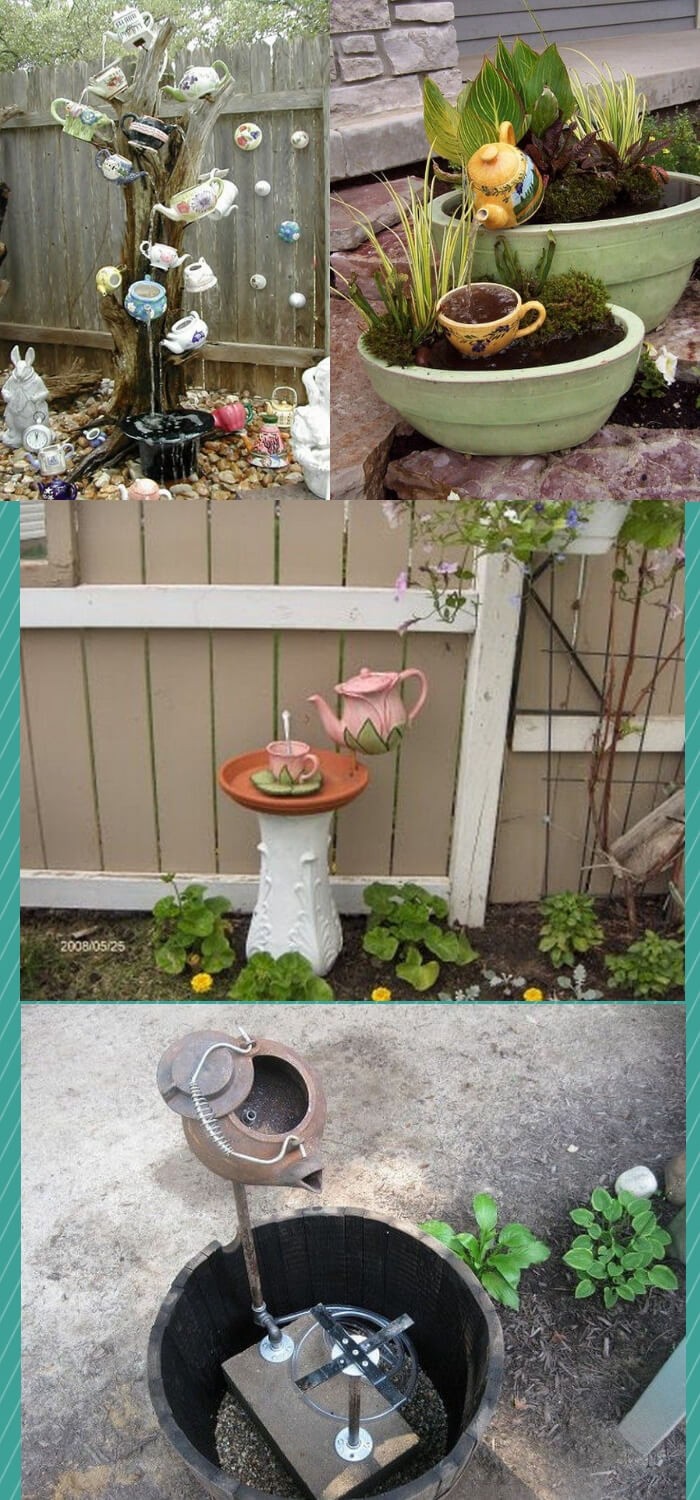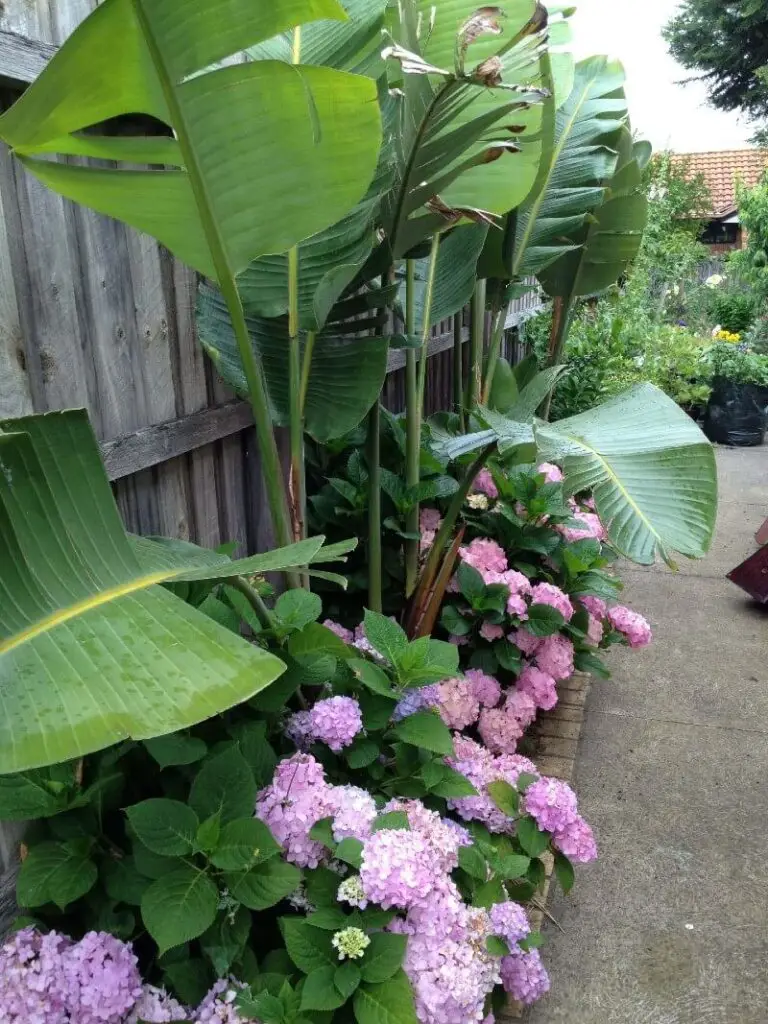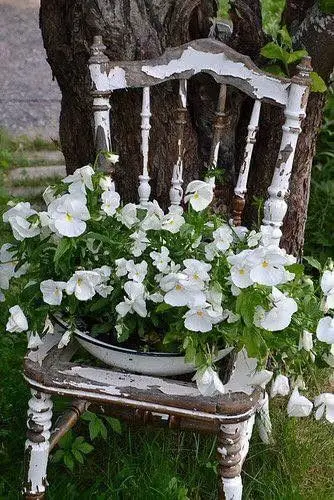20 Dining Room Accent Wall Ideas For A Statement-Making Space
Are you looking to revamp your dining room’s ambiance? One effective way to do so is by introducing an accent wall. This design element can be achieved through various methods, including painting, wallpapering, adding wainscoting, or incorporating tile, among others. In this article, we’ll explore some of the most impressive accent wall ideas for a dining room, as well as provide valuable tips on selecting the ideal color and style to complement your space.
Whether you’re seeking to create a bold statement or introduce subtle sophistication, our guide will walk you through every step of the process. So, if you’re ready to give your dining room a fresh makeover, keep reading!
14 Dining Room Accent Wall Ideas.
One of the most popular trends in home design today is the accent wall, a clever way to add personality and create focal points in large rooms. And what better place to incorporate this design element than the dining room? An accent wall is essentially one wall that’s been given special treatment, which can be achieved through various means such as painting it a distinct color, covering it with wallpaper or tile.
While typically a single feature wall, there’s no rule prohibiting the use of two or even three accent walls. If you’re seeking inspiration for your dining room accent wall, we’ve got you covered. Our ideas range from understated and subtle to bold and dramatic, ensuring that there’s an option perfect for any space.
Paint it a different color
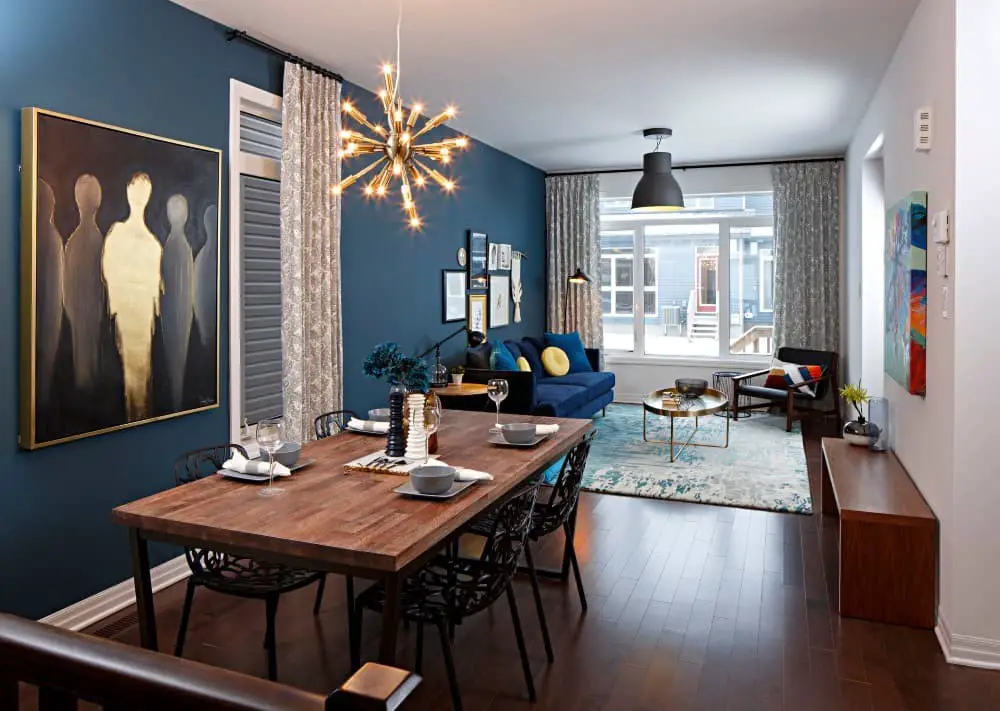
One of the most sought-after methods for adding an accent wall is by painting a single wall in a distinct hue. This approach is both practical and cost-effective, as it can significantly alter the ambiance of a room without requiring a full-scale makeover.
Use wallpaper

One alternative to painting an accent wall is using wallpaper, which offers numerous exciting options. This design element can be used to infuse your dining room with personality, regardless of the style you choose. You can opt for bold and graphic patterns or more understated classic designs that add a touch of sophistication.
Add wainscoting
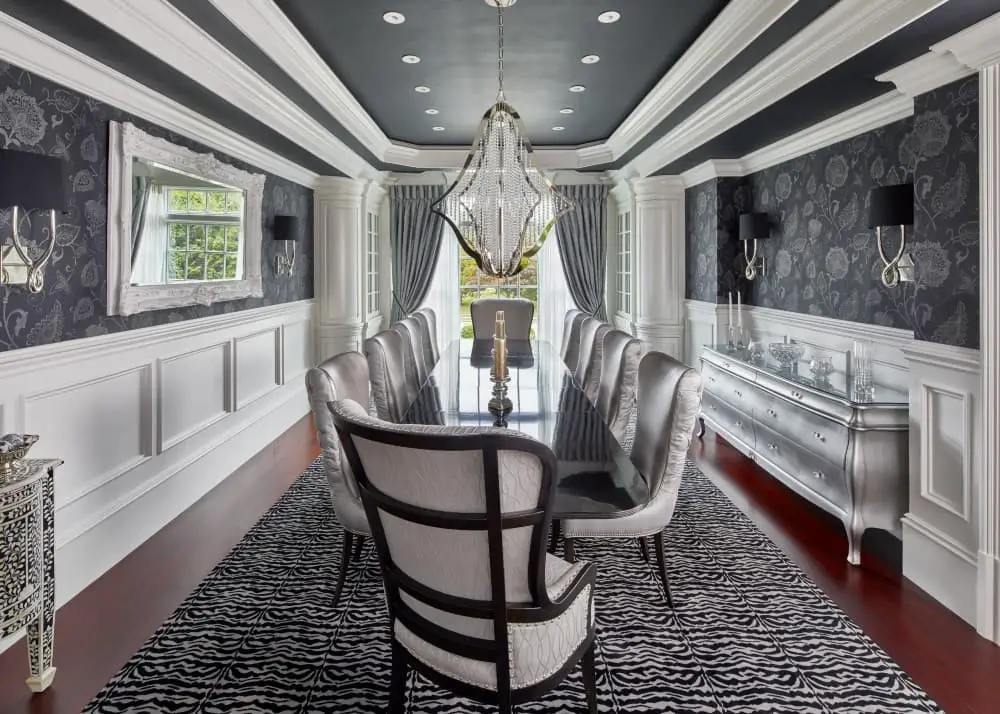
Wainscoting is a stylish and sophisticated accent wall option that can elevate the ambiance of any space. For those unfamiliar with this design element, wainscoting refers to a type of wood paneling that’s often used on the lower half of a wall. This versatile feature can be painted or stained, making it an excellent way to add depth, texture, and visual interest to your dining room.
Use tile
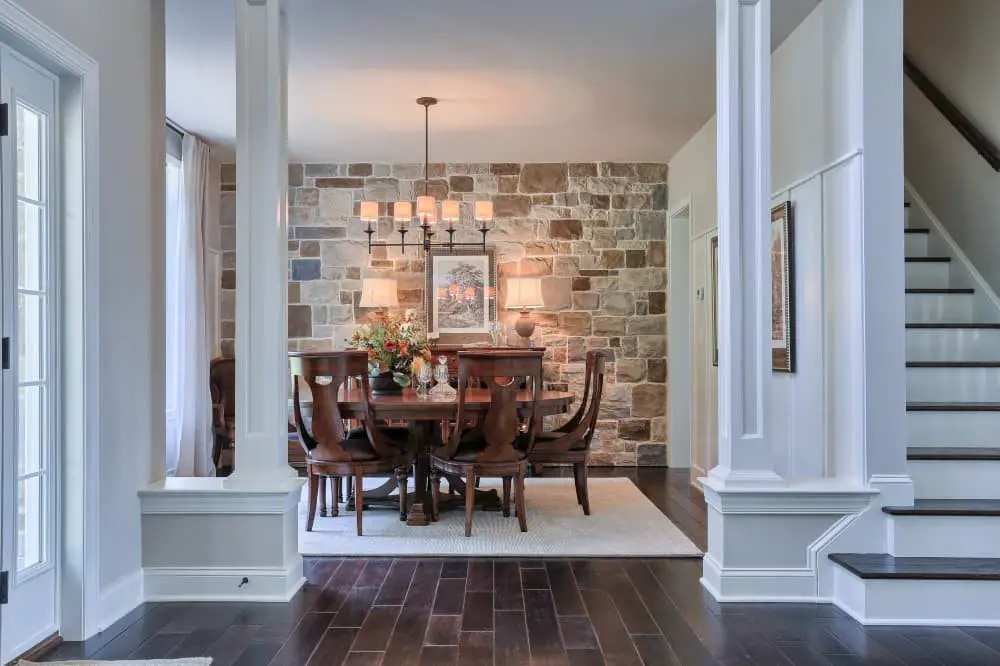
Another fantastic way to incorporate an accent wall into your design is by utilizing tile. Not only is it straightforward to install, but you also have the flexibility to tailor it to your specific space. With a vast array of color and pattern options available, you can create a truly eye-catching accent wall that adds visual interest and personality to any room.
Go for bold
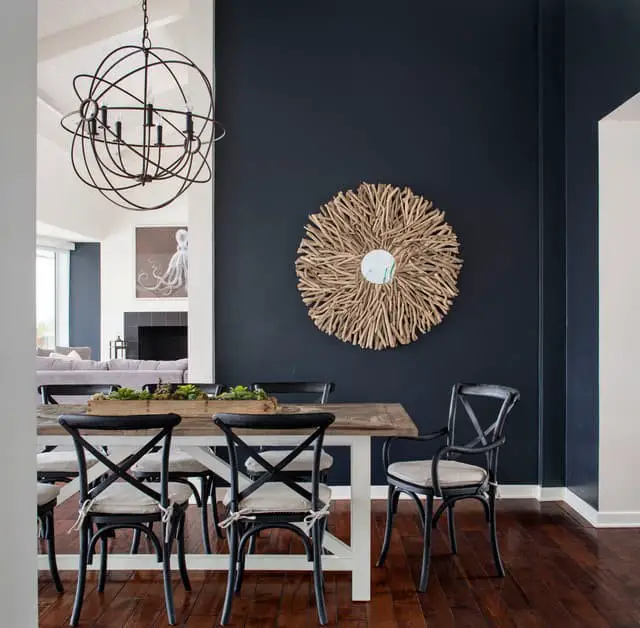
To truly bring out the best in your accent wall, consider choosing a vibrant color or striking pattern. By doing so, you’ll not only add a touch of individuality to your room’s aesthetic but also create a sense of energy and visual interest that can’t be replicated by more subdued options. The boldness of your choice will undoubtedly draw attention and become the focal point of the space.
Hang a tapestry
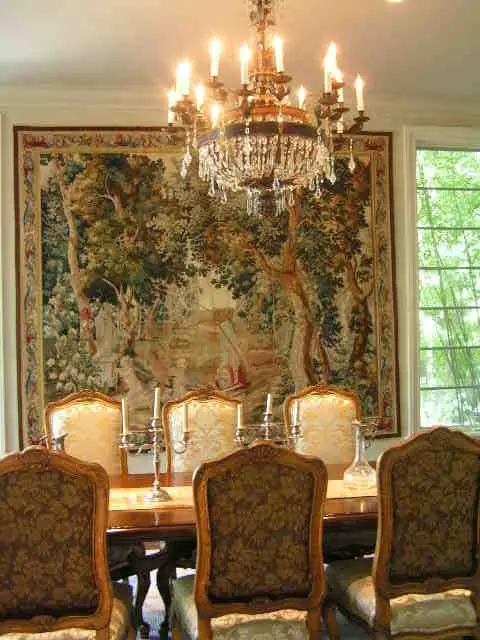
Tapestries are gaining traction as a creative solution for accent walls. When you have a tapestry that resonates with you, consider displaying it prominently in your dining room. This unique approach injects vibrancy and visual interest into the space, making a bold statement that reflects your personal style.
Hang artwork
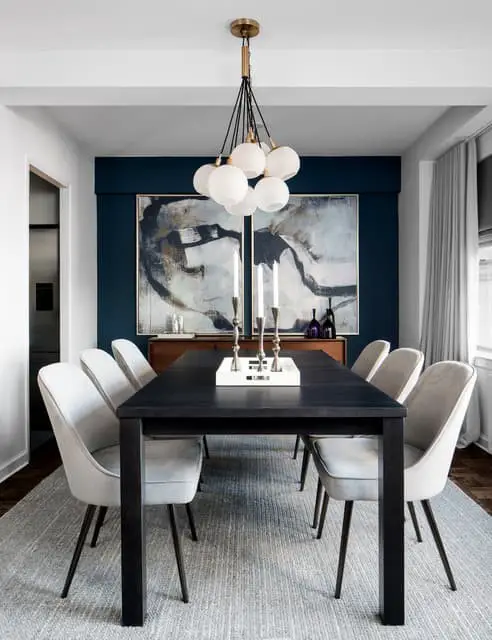
Enlivening your dining space with artwork can be an excellent approach to introducing a focal point. Consider selecting pieces that harmonize with the existing color palette or ones that boldly make a statement. To optimize visual impact, strategically place the artwork at eye level, allowing it to seamlessly blend into the ambiance.
Install shelving
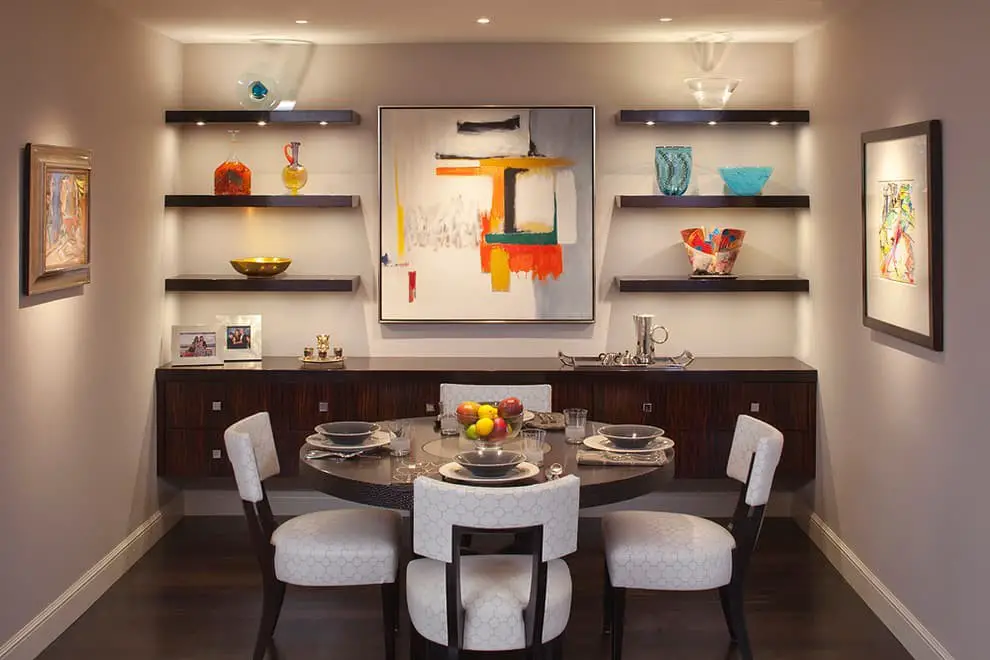
Transforming your dining room with shelving is an excellent way to create a focal point. By showcasing your favorite dinnerware, glassware, or other decorative items, you can add visual interest and personality to the space.
Paint a mural
Consider injecting a touch of creativity into your home decor by transforming an accent wall in your dining room into a vibrant work of art. A mural can be a fantastic way to infuse your space with character and make a lasting impression on visitors. By embracing your artistic side, you can create a unique and personalized design that reflects your style and personality.
Add a clock
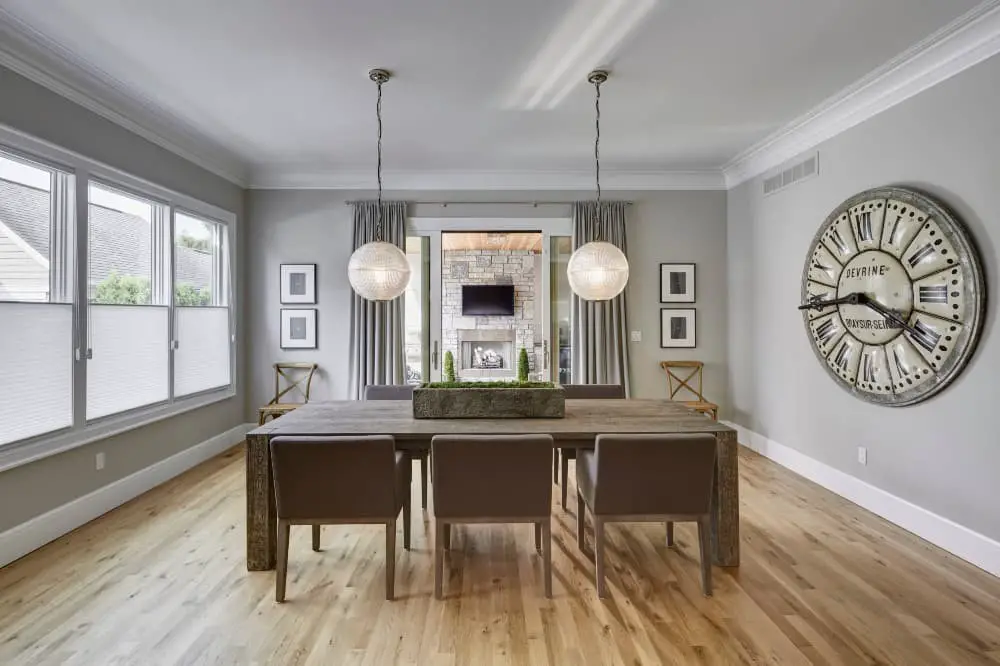
Elevate your dining room’s ambiance with a clock that serves as both a functional time-teller and a stylish accent piece. Select a model that harmonizes with the existing decor, allowing it to become a focal point that adds depth and visual interest to the space.
Use mirrors
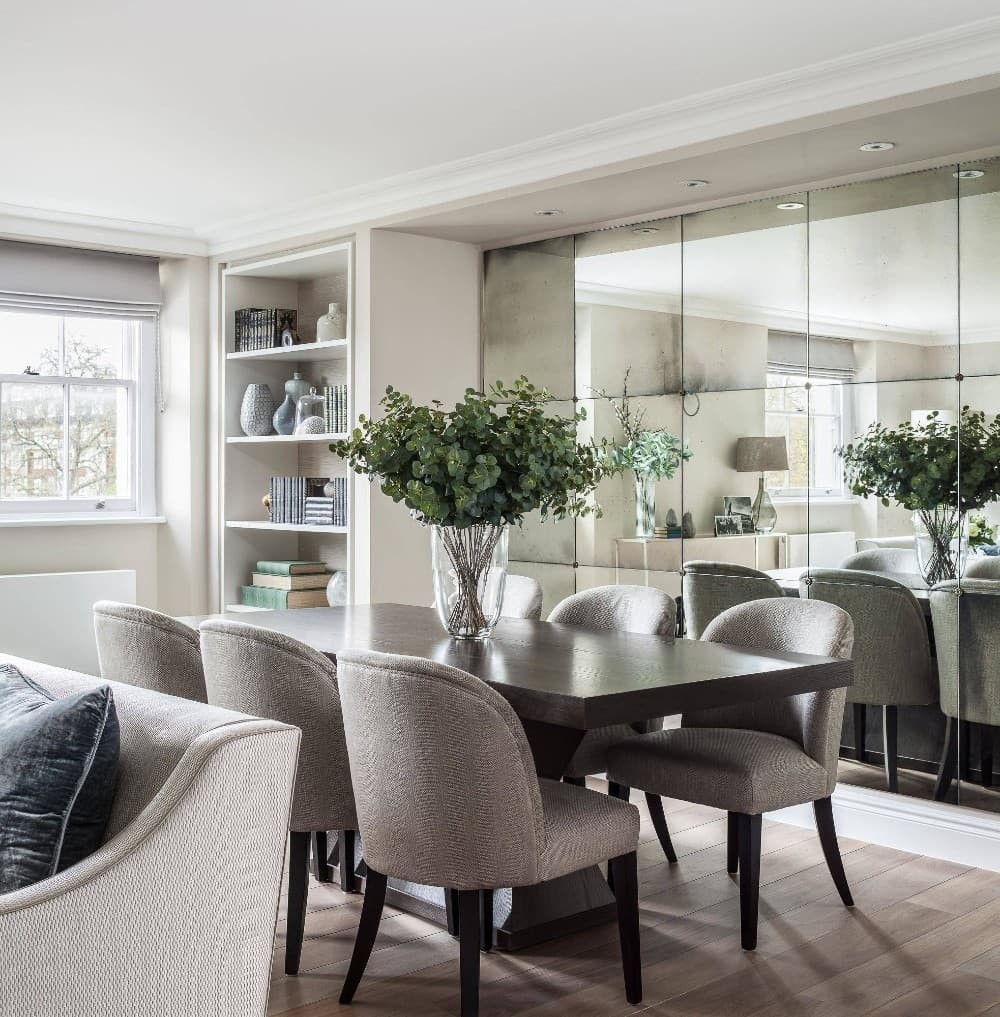
Small spaces often benefit from clever tricks to enhance their perceived size. One effective technique is incorporating mirrors into the design. Not only do they visually expand the room, but they also cleverly reflect light, banishing any sense of darkness. If you’re looking to create a more expansive feel in your dining area, consider strategically placing mirrors on the walls to create an illusion of greater proportions.
Paint the ceiling
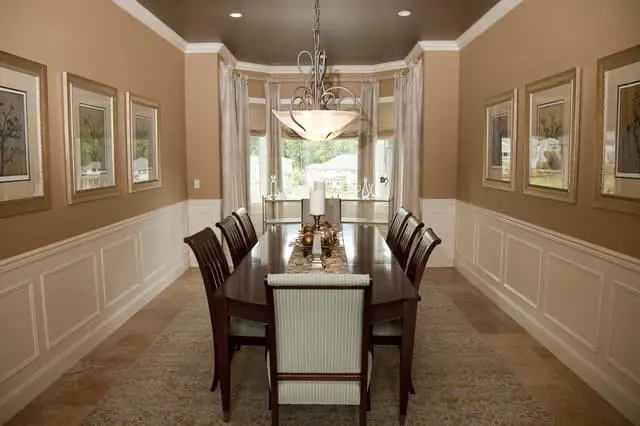
Elevate the ambiance of your space by introducing an unexpected pop of color. By painting the ceiling in a bold hue, you’ll not only create visual interest but also cleverly manipulate the room’s perceived height. The upward gaze will be naturally drawn to the ceiling, effectively elongating the space and imbuing it with a sense of grandeur.
Use natural stone
When it comes to adding depth and visual appeal to a space, natural stone is a popular choice. One creative way to incorporate this material is by repurposing it from a stone fireplace to create an accent wall in your dining room. The resulting design can add warmth, texture, and character to the area.
Use Shiplap:
Shiplap has gained immense popularity as a wall cladding material, effortlessly lending texture and charm to dining rooms. Its ease of installation makes it an ideal choice for those who don’t wish to undertake major renovations. Furthermore, shiplap’s versatility allows for customization through painting or staining, or leaving it in its natural state for a rustic ambiance.
Wooden slats
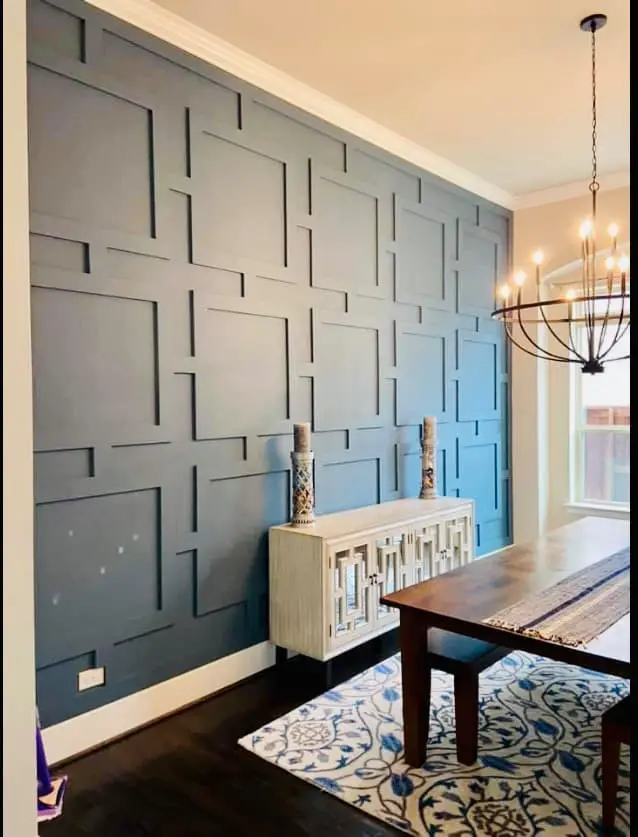
Transform your dining room into a cozy haven by introducing wooden slats on one wall. This DIY-friendly project is surprisingly easy to execute and will inject texture and visual intrigue into the space. The wooden slats can be painted in a hue that harmonizes with your existing decor, or you can opt for a natural finish for a charming rustic ambiance.
Wood dining room accent wall ideas.
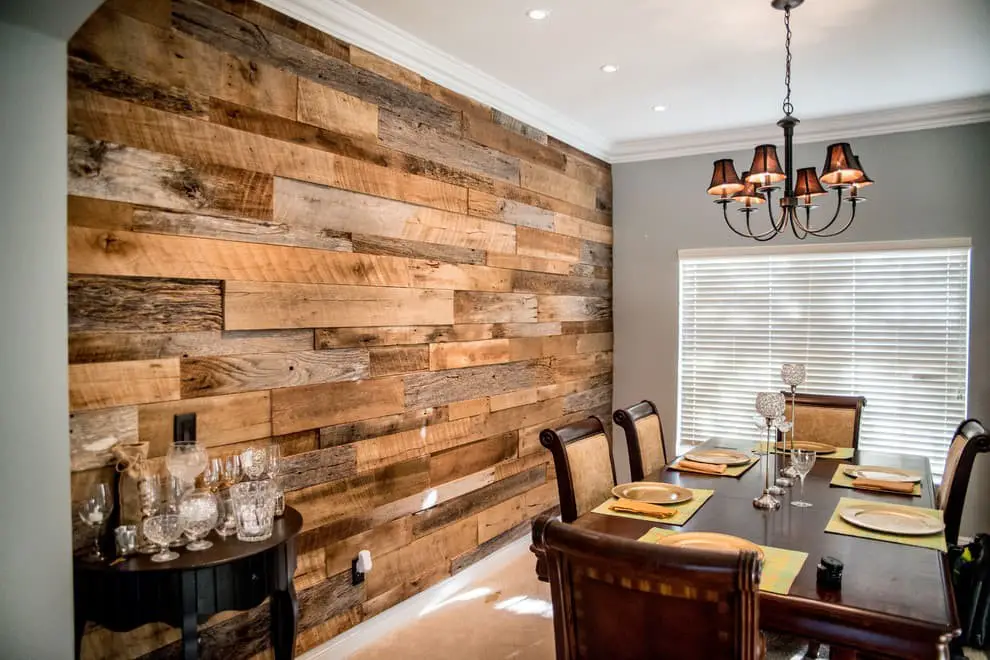
Wooden dining room walls are an excellent way to inject warmth and personality into any home. To achieve this unique look, consider incorporating various wood accents, such as reclaimed wood, stained or painted wood, or even a combination of both. Reclaimed wood, for instance, adds a touch of history and character, while stained or painted wood allows you to experiment with different colors and finishes to suit your desired aesthetic.
For those seeking a more modern appearance, look no further than stained or painted wood. This versatile material can be used to create a range of looks, from rustic to contemporary, allowing you to easily adapt it to your dining room’s style. And if you want to add an extra pop of color, consider using stained or painted wood as the focal point of your accent wall. If you’re looking for something truly unique, why not try incorporating mosaic tiles?
These small, intricately arranged pieces can be used to create a wide range of designs and patterns, from rustic to sleek. Mosaic tiles are an excellent way to add some visual interest to your dining room while also creating a one-of-a-kind look. Finally, for those who appreciate timeless elegance, brick is a classic choice that never goes out of style. This durable material has been used for centuries to create beautiful structures and can be used to add warmth and coziness to your dining room.
Whether you’re looking for a rustic or modern aesthetic, brick provides the perfect backdrop for any dining room.
Best color for dining room accent wall.
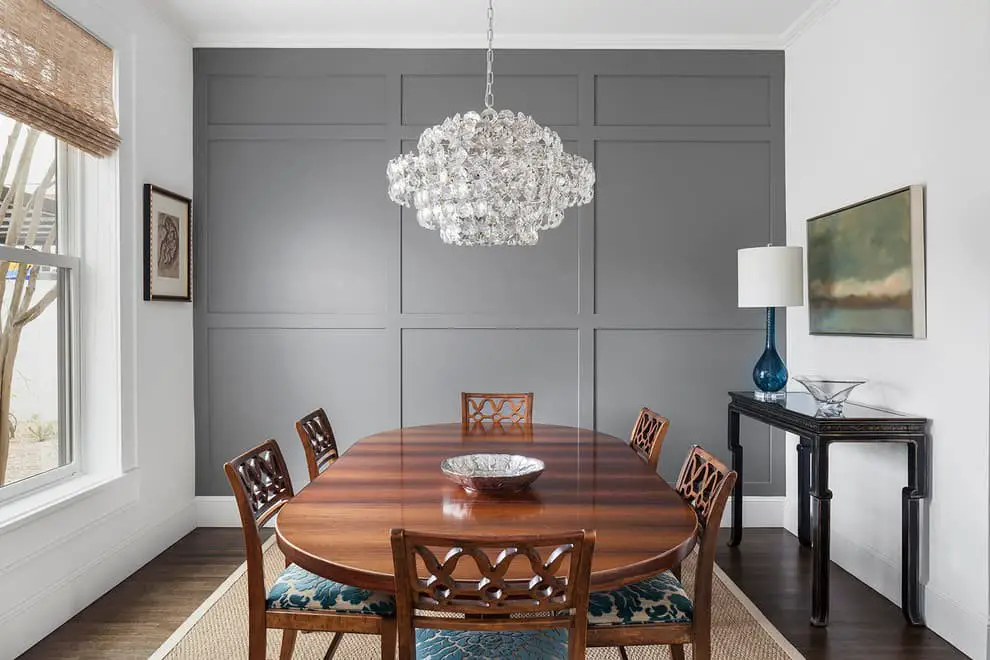
While there are numerous options when it comes to selecting an accent color for a dining room, some of the most effective choices include rich hues like deep red, blue, or green. These bold shades can add depth and visual interest to the space, creating a warm and inviting atmosphere. For a more calming and serene ambiance, consider a lighter shade of one of these colors.
Alternatively, if you want to introduce a touch of drama to the room, dark colors such as black or charcoal grey can be used to create a sophisticated and formal feel. Ultimately, when choosing an accent color, it is crucial to consider the overall aesthetic of the room, ensuring that the accent wall complements rather than clashes with the surrounding decor.
How to choose an accent wall in dining room
When it comes to selecting an accent wall for your dining room, there are several factors to consider. One of the most important is the size of the space itself. Accent walls tend to work particularly well in smaller rooms, as they can help create a sense of intimacy and coziness. In larger spaces, however, you may want to consider alternative options, such as an accent piece of furniture or a mural. Another crucial consideration is the color palette already present in your dining room.
You’ll want to choose an accent wall color that complements the existing hues, rather than clashing with them. This will help create a cohesive and harmonious look. The mood you hope to create in your dining room is also important. An accent wall can play a significant role in setting the tone for the entire space. If you’re aiming for a warm and inviting atmosphere, a rich and dark color might be just what you need.
On the other hand, if you want to inject some energy and fun into the space, a bright and bold color could be the way to go. Ultimately, your personal style should also influence your decision. Are you a traditionalist who prefers classic colors like white or beige? Or do you lean towards something more modern and bold? Your accent wall should reflect your individual taste and aesthetic. Finally, don’t forget to consider the type of dining room you have.
For formal spaces, a classic color might be the best choice, while more casual rooms can accommodate bolder and brighter hues.
Which wall should be the accent wall in a dining room?
To create an accent wall, the answer is surprisingly simple: any wall will do! The goal is to add contrast and visual interest to a room. This can be achieved by highlighting a special feature, such as a fireplace or piece of art, or simply injecting some color into the space.
There’s no one-size-fits-all approach when it comes to selecting an accent wall. However, a few key considerations come into play. First, think about the overall aesthetic you’re aiming for in the room.
What is the dominant design style? You want your accent wall to complement this rather than clash.
Next, consider the purpose of the room. For instance, if it’s a dining space meant for entertaining, you may want to choose a wall that’s visible from the entryway or living area.
Lastly, don’t forget about your personal taste. Do you prefer bold statements or more understated designs? Your accent wall should reflect this.
Can you have an accent wall in the dining room?
Adding a touch of personality to your dining room is just a paint stroke away! An accent wall can bring a burst of color and create a striking focal point. If you’re feeling unsure, we’ve got some inspiration to get you started. A pop of color in your dining room? No problem! Paint one wall a bold hue or cover it with durable, easy-to-clean wallpaper that withstands high traffic. For a unique focal point, an accent wall is the perfect canvas.
Hang a striking piece of art, or even mount a TV (just be mindful not to distract from dinner conversations). The possibilities are endless!
What kind of art should I hang in my dining room?
When selecting art for your dining room, it’s crucial to consider several factors to ensure the perfect fit. While personal taste plays a significant role, there are some general guidelines that can help you make an informed decision. Firstly, think about the atmosphere you want to create in the room. Do you envision a sophisticated and elegant space or a cozy and relaxed one? The art you choose should harmonize with your desired ambiance.
Next, take into account the dominant colors in your dining room. The art you select should complement these hues to create visual cohesion. Additionally, consider the size of your dining room. A smaller space requires more understated pieces, while a larger room can accommodate bolder and more dramatic artworks. Finally, remember to hang art at eye level to create the illusion of more space in the room and maintain a sense of balance.
Conclusion
When it comes to giving your dining room a unique touch, an accent wall can be a fantastic choice. This design element offers endless possibilities for customization, allowing you to infuse your space with personal style. Whether you opt for a vibrant color, a striking pattern, or something more understated, an accent wall provides the perfect opportunity to add character and personality to your dining room.
So don’t be afraid to get creative and let your imagination run wild – the possibilities are truly endless!

